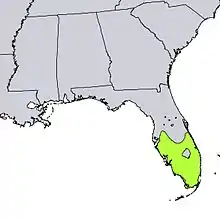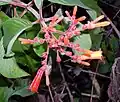Hamelia patens
Hamelia patens is a large perennial shrub or small tree in the family Rubiaceae, that is native to the American subtropics and tropics. Its range extends from Florida in the southern United States to as far south as Argentina.[3] Common names include firebush, hummingbird bush, scarlet bush, and redhead. In Belize, this plant's Mayan name is Ix Canaan and is also known as "Guardian of the Forest".
| Hamelia patens | |
|---|---|
 | |
| Habitus | |
| Scientific classification | |
| Kingdom: | Plantae |
| Clade: | Tracheophytes |
| Clade: | Angiosperms |
| Clade: | Eudicots |
| Clade: | Asterids |
| Order: | Gentianales |
| Family: | Rubiaceae |
| Genus: | Hamelia |
| Species: | H. patens |
| Binomial name | |
| Hamelia patens Jacq., 1763 | |
 | |
| Natural range in United States | |
| Synonyms[2] | |
|
List
| |
Growth

Firebush has orangish-red tubular flowers, which recruit hummingbirds and butterflies for pollination.[4] The corollas vary greatly in length, making them attractive to a wide range of pollinators.[5] The fruit is a small dark red berry, turning black at maturity.[6]
Despite its somewhat scraggy appearance, this is a valuable garden tree in warmer climates and even in temperate ones, as long as the soil remains above freezing.[4]
Uses
Hummingbirds are attracted by its flowers and other birds feed on the fruit, both of which will also forage on small insects found in the vicinity, helping to keep down pests. These flowers are also fed on by butterflies, such as the statira sulphur (Aphrissa statira), which are attracted to red flowering plants. The fruits have a refreshing, acidic taste and are also edible by humans; in Mexico, they are made into a fermented drink.
Folk medicine
The plants are used in folk medicine for a range of ailments.[7]
Chemical constituents
A number of active compounds have been found in firebush, including maruquine, isomaruquine, pteropodine, isopteropodine, palmirine, rumberine, seneciophylline and stigmast-4-ene-3,6-dione.[8] The bark contains significant amounts of tannins.
Gallery
 Inflorescence
Inflorescence Foliage
Foliage Pollen of Hamelia patens (Size: ~38 microns)
Pollen of Hamelia patens (Size: ~38 microns)
References
- Botanic Gardens Conservation International (BGCI); IUCN SSC Global Tree Specialist Group; Cornejo-Tenorio, G.; Ibarra-Manríquez, G.; Lorea Hernández, F. (2019). "Hamelia patens". IUCN Red List of Threatened Species. 2019: e.T136789578A136789580. doi:10.2305/IUCN.UK.2019-2.RLTS.T136789578A136789580.en. Retrieved 22 November 2022.
- "The Plant List: A Working List of All Plant Species". Theplantlist.org. Retrieved March 13, 2014.
- "Hamelia patens". Germplasm Resources Information Network. Agricultural Research Service, United States Department of Agriculture. Retrieved 2009-12-17.
- Welch, Willam C. (2003): Horticulture Update - Firebush (Hamelia patens) Archived 2007-07-15 at the Wayback Machine. Version of June 2003. Retrieved 2009-08-25.
- Fenster, Charles B. (1991): Selection on Floral Morphology by Hummingbirds. Biotropica 23(1): 98-101. doi:10.2307/2388696 (First page image)
- Francis, John K. (undated) Update (Hamelia patens) Retrieved 2009-08-25
- "Hamelia patens". Floridata.com. Retrieved 29 June 2022.
- Duke, Jim (2007): Dr. Duke's Phytochemical and Ethnobotanical Databases - Hamelia patens. Retrieved 2007-09-19.
External links
 Media related to Hamelia patens at Wikimedia Commons
Media related to Hamelia patens at Wikimedia Commons Data related to Hamelia patens at Wikispecies
Data related to Hamelia patens at Wikispecies
